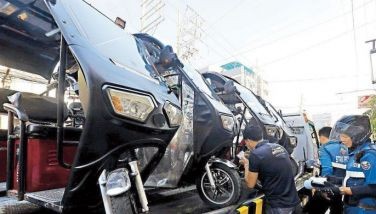#Journeyto30 State of rebellion; state of cohesion
MANILA, Philippines – This past week, the Armed Forces of the Philippines (AFP) seems to have found its voice in the reopening of the Senate inquiry on the botched police operation in Mamasapano a year ago.
In a PowerPoint presentation during the inquiry, AFP deputy chief of staff for operations Maj. Gen. Angelito de Leon showed a photo of retired police director Getulio Napeñas, who directed the operation to capture wanted international terrorist Marwan.
The photo, taken in the afternoon of Jan. 25, 2015, hours after the Mamasapano clash, showed Napeñas smiling and in civilian attire while meeting with military counterparts at the AFP 1st Mechanized Brigade headquarters.
“Here, Director Napeñas and party were still in civilian attire and can even afford to smile in spite of the dire situation faced by his troops in the encounter site,” De Leon said, adding that the former Special Action Force (SAF) commander was “detached from the reality” and had a “walk-in-the-park” mindset about the operations.
De Leon’s words represent the AFP’s united front regarding its responsibility in the Mamasapano clash, and speak of the current overall cohesive state within the military organization.
But the AFP wasn’t always a solid institution. Its past is replete with divisive actions and power struggles that tested the unity of the organization and threatened the security of the nation.
One such event was the Oakwood mutiny on July 27, 2003 that took place at the Oakwood Premier serviced apartments in Makati City. The Philippine STAR captured in its July 28, 2003 front page the moment when leaders and members of the so-called Bagong Katipuneros (also known as the Magdalo Group), led by Army Capt. Gerardo Gambala and a young and feisty LtSG. Antonio Trillanes IV, aired their grievances against the administration of then-president Gloria Macapagal-Arroyo and the chain of command of the AFP.
The Magdalo Group lamented the sorry state of the armed forces, beleaguered as it was by a lackluster modernization program, inadequate services for wounded and sick soldiers, lack of death benefits for families of soldiers killed in action and corruption, among others.
More than a decade after the mutiny, some of the mutineers’ grievances remain unaddressed and unresolved. Although there is much progress with the modernization program following the acquisition of two US Coast Guard cutters as frigates, the purchase of new land, air and naval assets, and the procurement of new military equipment for the different branches of the armed forces, the AFP still remains one of the least formidable in Southeast Asia.
The Philippines currently ranks 40th in the Global Firepower 2016 Power Index, behind Indonesia (12th), Thailand (20th), Vietnam (21st), Singapore (26th) and Malaysia (35th), but ahead of Myanmar (44th), Cambodia (94th) and Laos (117th).
With the internal and external threats that continue to hound our porous borders and multicultural society, our armed forces still have to improve by leaps and bounds before we can attain a truly competent defense and security posture for our nation.
We can only do that if the AFP remains steadfast, committed and consistent with its modernization and fight against corruption, and if our soldiers remain united and faithful to such cause.
- Latest
- Trending


























